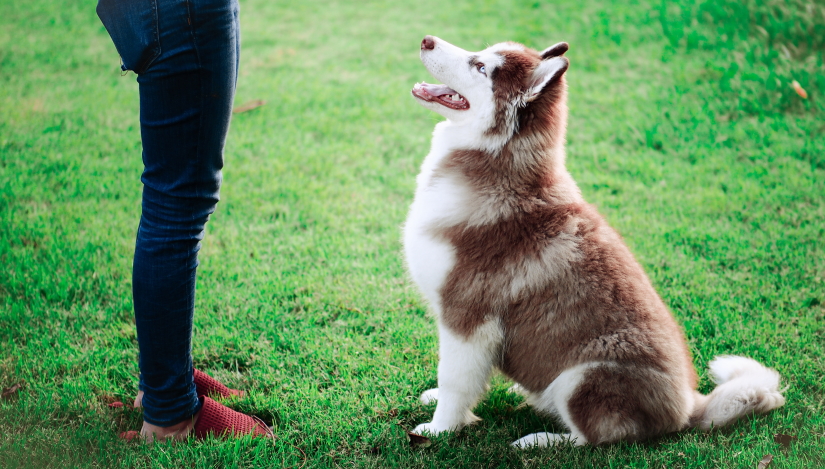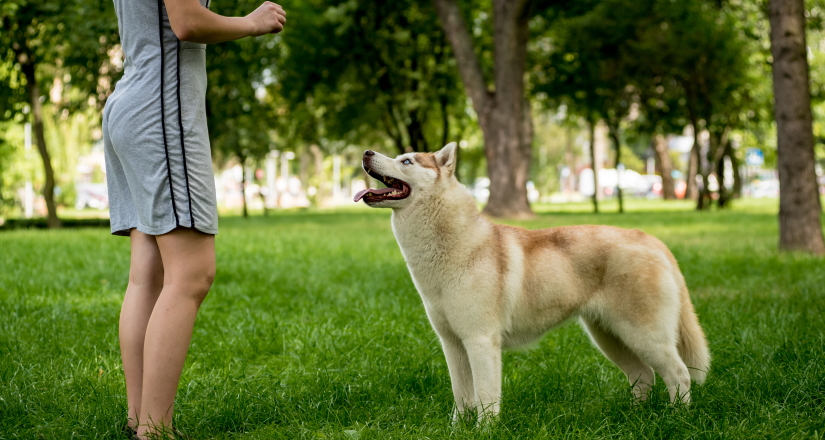Northern breeds such as the Husky are also known as Spitz dogs. The Husky is a multi-purpose dog that enjoys hunting, herding and sledding. Most of the northern breeds such as the Husky and Akita enjoy being independent, and are sometimes aloof around people.
Some also have a hard time forming a strong bond with one person, and enjoy having their space to roam. Siberian Huskies have a tendency to escape. They enjoy hunting and have a strong predatory instinct which makes positive training all the more important for this breed.
The Husky is a high-energy breed that needs to be socialized from an early age. These dogs do well with other dogs and form strong friendships. They are real pack animals and need to be part of your pack. Establish your hierarchy early on with effective dog training.
Siberian Husky Dog Training Tips
Since this breed does well with an active family who is knowledgeable about Huskies, your entire family needs to participate in training and activities to keep your Husky physically exercised and mentally stimulated. Hiking, skijoring, biking, and even cross-work works well for these dogs, but they need to be kept cool at all times.
Start your training early during puppyhood to prevent undesirable behavior from becoming a habit. Huskies will definitely test the waters to see what they can or cannot do. Make sure all members of the household are on the same page when deciding on house rules for your Husky. Be consistent in enforcing the rules and work together with a positive dog trainer.
Huskies can become difficult to train if training is neglected during the puppy stage. Always approach your dog’s training with dedication and patience, and treat your dog fairly at all times.

Training Tips
- Develop a true understanding of your dog and your dog’s breed. Read about canine genetics.
- Never blame your dog for what he cannot do. Explore all your options and find a great trainer and behaviorist.
- Know who your dog is, what he likes and why he acts the way he does. Match specific training skills to his unique quirks. You want him to listen, but you never want to curb his personality.
- Always have patience, kindness and a willingness to learn from your mistakes. Work together with your trainer and participate in virtual online dog training.
- Enjoy your dog and value every moment you get to spend with him. Training takes time and does not happen overnight.
How to Train a Husky?
It’s always a good idea to enroll in an obedience class in your area. If your Husky is a show dog, take him to conformation training classes. Many communities have dog clubs that offer dog training classes and preparation classes to prepare your Husky for obedience competition. There is also the option of having a positive trainer come to your home, or to find classes outside your home.
During obedience trials, Huskies can earn titles at various levels of competition. With that said, the beginning levels start off with the basics like sit, heel, stay, etc. When you start competing in the more advanced levels of competition your Husky will have much more fun. These will include jumping, scent discrimination, retrieving and signal work. Obedience school will include:
- Hour-long sessions once a week.
- This lasts for six to eight weeks.
- Practice after each training lesson for a few minutes each day.
- If training and homework are done in the right way, the training procedure will be faster, resulting in a happy and well-mannered canine companion.
- Huskies are intelligent and learn quickly.
- Keep training sessions short so that your Husky can focus.
- Praise and reward every time that your Husky performs a command.

Siberian Husky Training
Discipline and dog training enables your dog to act in accordance with your house rules, and brings the necessary order to a life with a Husky, even if he’s an adolescent. Without dog training and discipline, many dogs end up at shelters due to behavioral problems that humans are mostly to blame for.
Learning has to be made easy and pleasant for your furry best friend. Dogs have to enjoy the end result so that they’ll repeat the behavior again. If you have a puppy that you’re trying to crate train, your puppy needs to feel secure in his environment and to develop clean living habits. To do so, it’s necessary to crate train from the very beginning when you first bring your puppy home.
6 Steps to Successfully Crate Train Your Husky
- Crate training is not a form of punishment, but a method used to help with housetraining your Husky.
- Each time you place your puppy in the crate, say “Crate time” and give him a small treat like a piece of cheese or chicken.
- Leave him in his crate for no longer than 5 minutes in the beginning-stay in the same room so that he’s not alone.
- Let him leave his crate and praise.
- Never release him from his crate if he’s making a big fuss. Wait until he’s relaxed and then let him out.
- Repeat this several times during the day.
- After 3 days let him stay in his crate for a little longer. Reward in the same manner.
- Always take your Husky puppy outside to relieve himself right after he comes out of his crate. Praise and reward.
- Start leaving the room, first for five minutes and then longer.
- Never leave your dog in his crate for longer than 3 hours.
If your dog is stressed or feels threatened, you will have a hard time training him to lie down. His instinct is to fight for survival. Thus, it’s necessary to always keep your Husky calm as he learns the down command.
The down command is taught after you’ve taught your Husky to sit. Large breeds find lying down and getting up soon afterward strenuous. Always use your dog’s curiosity when training, most especially when training to “Come”. Most dogs will come looking for you if you hide. Reward with a treat.

Many dogs will think that the word “come” is the end of their training and fun. That’s because they’ve associated the word “come” with the leash and the end of training. Reward him when he comes to you, then let him go back to playing again.
Using the “Come” command will be less effective when your Husky is out playing with other dogs, so you should wait for a lull in play, and then give the “Come” command. Instill confidence in your dog at all times, and learn how to communicate effectively with your Husky by taking part in some dog training classes.
